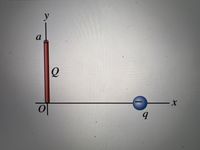Question
11. Calculate the x-component of the electric field produced by the charge distribution ‘Q’ at points on the positive x-axis.
Calculate the y-component of the electric field produced by the charge distribution ‘Q’ at points on the positive x-axis.
Calculate the x-component of the force that the charge distribution ‘Q’ exerts on ‘q’.
Calculate the y-component of the force that the charge distribution ‘Q’ exerts on ‘q’.
Please answer all in terms of variables q,Q,x,y,a and constant k.

Transcribed Image Text:Positive charge Q is distributed uniformly along the positive
y-axis between y = 0 and y = a. A negative point charge -q
lies on the positive x-axis, a distance x from the origin (Figure 1).

Transcribed Image Text:a
Expert Solution
This question has been solved!
Explore an expertly crafted, step-by-step solution for a thorough understanding of key concepts.
This is a popular solution
Trending nowThis is a popular solution!
Step by stepSolved in 2 steps with 2 images

Knowledge Booster
Similar questions
- 4. Determine the magnitude and direction of the electric field acting on an electron that is projected onto the x-axis with an initial speed of 2.5x10^6 m/s, moves 45.0 cm, and stops due to the uniform electric field in the region.Note: The charge and mass of the electron are, respectively: q =-e = 1.6×10^-19 C and m. = 9.1×10^-31 kg.arrow_forwardPls help ASAParrow_forwarda) A particle with a mass of 0.003 grams and a charge of-5x10°C was placed in an upward electric field with a magnitude of 350,000 N/C. What is the direction of the acceleration that the particle will feel? 22 b) What is the magnitude of the acceleration that the particle will feel? b) If it is in the field for 0.25 seconds, how far will it go?arrow_forward
- 1) Charge for q2 = 6.00 x 10^-12 C. Determine the magnitude of the electrical field. Express the answer in N/C form. 2) Using a new value of 7.4 nC for q2, determine the charge needed at point P so that the electric field due to all four charges is zero at point z. Express your answer in nC and include a negative sign if the charge is negative. Please use what I have provided for the questions.arrow_forwardApply error propagation to determine the associated uncertainty in the average volume… Plzarrow_forward-6.0 x 10¹5 C N >E 2.0 m - 6.0 x 105 C 3.0 m 4.0 x 10-5C A 9₂ 3.0 m 2.0 m 2 -3.0 x 10-5 C • A a. Determine the net electric field at point A. b. The magnitude of the electric field due to each charge, (i.e. calculate 1 and ₂), at point A. a. For each part in practice question 1, find the net force on a -1.2 × 10-5 C charge placed at point A. b. How would your answer change if the sign of the charge from 2a at point A was changed?arrow_forward
- A positive charge of magnitude Q1 = 0.45 nC is located at the origin. A negative charge Q2 = -6.5 nC is located on the positive x-axis at x = 17 cm from the origin. The point P is located y = 17 cm above charge Q2. a) Calculate the x-component of the electric field at point P due to charge Q1. Write your answer in units of N/C. b) Calculate the y-component of the electric field at point P due to charge Q1. Write your answer in units of N/C. c) Calculate the y-component of the electric field at point P due to the Charge Q2. Write your answer in units of N/C.arrow_forward2. Suppose that charge #1 is positioned at the origin (x = 0 m, y = 0 m) and has a magnitude of +2.6 μC, and that charge #2 is positioned on the y-axis at y = 0.16 m and has a magnitude of -4.3 µC. Find the x- and y-components of the electric field on the x-axis at x = 0.21 m. Also, find the x- and y-components of the force on a charge of +6.3 nC placed at this point (x = 0.21 m).arrow_forwardA long, thin wire along the x-axis has a linear charge density of 8.8e-6 C/m. a) Find the magnitude of the electric field at point p a distance of 0.8 m from the wire. b) Find the magnitude of the net force on a test charge of 8e-6 C at point p. c) Which direction will the test charge accelerate? parallel to wire perpendicular to and toward wire perpendicular to and away from wirearrow_forward
arrow_back_ios
arrow_forward_ios